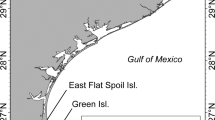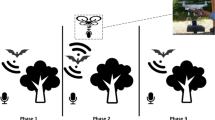Abstract
Created wetlands play an important role in the conservation of Least Bitterns (Ixobrychus exilis) by compensating for the loss of natural wetlands. In 2011, we studied habitat relationships of a major population breeding in a 128-ha cattail- and bur-reed-dominated impoundment in Quebec. We surveyed for bitterns and recorded habitat parameters at 30 points, making novel use of a small unmanned aircraft system (UAS) to obtain fine-scale land cover data. A model-selection approach based on Akaike’s information criterion (AIC) determined that breeding density was best predicted by cattail cover in combination with water-vegetation edge density (Akaike weight = 0.88). Breeding density was unrelated to water depth, contrary to a previous study at the site after a dyke breach significantly lowered water levels, suggesting that above a certain depth threshold other habitat preferences take precedence. We recommend that management of created wetlands for Least Bitterns focus on maintaining stable water levels of at least 25 cm on average during the breeding season and manipulating them as required later on in order to promote hemi-marsh conditions. UAS can enhance wetland habitat research and monitoring by improving the precision and efficiency of data collection in the field while reducing disturbance compared to ground-based surveys.


Similar content being viewed by others
References
Anderson K, Gaston KJ (2013) Lightweight unmanned aerial vehicles will revolutionize spatial ecology. Front Ecol Environ 11:138–146
Bancroft GT, Gawlik DE, Rutchey K (2002) Distribution of wading birds relative to vegetation and water depths in the Northern Everglades of Florida, USA. Waterbirds 25:265–277
Bogner HE, Baldassarre GA (2002) Home range, movement, and nesting of Least Bitterns in western New York. Wilson Bull 114:297–308
Bolenbaugh JR, Krementz DG, Lehnen SE (2011) Secretive marsh bird species co-occurrences and habitat associations across the Midwest, USA. J Fish Wildl Manag 2:49–60
Burnham KP, Anderson DR (2002) Model selection and inference: a practical information-theoretic approach. Springer, New York
Burnham KP, Anderson DR, Huyvaert KP (2011) AIC model selection and multimodel inference in behavioral ecology: some background, observations, and comparisons. Behav Ecol Sociobiol 65:23–35
Chabot D, Bird DM (2012) Evaluation of an off-the-shelf unmanned aircraft system for surveying flocks of geese. Waterbirds 35:170–174
Chabot D, Bird DM (2013) Small unmanned aircraft: precise and convenient new tools for surveying wetlands. J Unmanned Veh Syst 1:15–24
Darrah AJ, Krementz DG (2010) Occupancy and habitat use of the Least Bittern and Pied-billed Grebe in the Illinois and Upper Mississippi River valleys. Waterbirds 33:367–375
Environment Canada (2014) Recovery strategy for the Least Bittern (Ixobrychus exilis) in Canada. Species at Risk Act Recovery Strategy Series, Environment Canada, Ottawa. http://www.registrelep.gc.ca/document/default_e.cfm?documentID=1291
Getzin S, Wiegand K, Schoning I (2012) Assessing biodiversity in forests using very high-resolution images and unmanned aerial vehicles. Methods Ecol Evol 3:397–404
Gilbert H (2011) Inventaire botanique en 2011 des étangs aménagés de Baie-du-Febvre – Rapport sommaire: comparaisons 2005–2011. Unpublished report by the Bureau d’écologie appliquée presented to Environment Canada, Quebec City
Harms TM, Dinsmore SJ (2013) Habitat associations of secretive marsh birds in Iowa. Wetlands 33:561–571
Horstman AJ, Nawrot JR, Woolf A (1998) Mine-associated wetlands as avian habitat. Wetlands 18:298–304
Jobin B, Latendresse C, Robillard L (2007) Habitats et inventaires du Petit Blongios sur les terres du Ministère de la Défense Nationale à Nicolet, Québec, étés 2004, 2005 et 2006. Technical Report Series no. 482. Canadian Wildlife Service, Environment Canada, Sainte-Foy
Jobin B, Robillard L, Latendresse C (2009) Response of a Least Bittern (Ixobrychus exilis) population to interannual water level fluctuations. Waterbirds 32:73–80
Jobin B, Fradette P, Labrecque S (2011a) Habitat use by Least Bitterns (Ixobrychus exilis) in Quebec. Waterbirds 34:143–150
Jobin B, Bazin R, Maynard L, McConnell A, Stewart J (2011b) Least Bittern (Ixobrychus exilis) survey protocol. Waterbirds 34:225–233
Jobin B, Mazerolle MJ, Bartok ND, Bazin R (2013) Least Bittern occupancy dynamics and detectability in Manitoba, Ontario, and Quebec. Wilson J Ornithol 125:62–69
Kaminski RM, Prince HH (1981) Dabbling duck and aquatic macroinvertebrate responses to manipulated wetland habitat. J Wildl Manag 45:1–15
Kaminski MR, Baldassarre GA, Pearse AT (2006) Waterbird responses to hydrological management of Wetlands Reserve Program habitats in New York. Wildl Soc Bull 34:921–926
Kent T (1951) The Least Bitterns of Swan Lake. Iowa Bird Life 21:59–61
Laliberte AS, Goforth MA, Steele CM, Rango A (2011) Multispectral remote sensing from unmanned aircraft: image processing workflows and applications for rangeland environments. Remote Sens 3:2529–2551
Lor S, Malecki RA (2006) Breeding ecology and nesting habitat associations of five marsh bird species in western New York. Waterbirds 29:427–436
Ma Z, Cai Y, Li B, Chen J (2010) Managing wetland habitats for waterbirds: an international perspective. Wetlands 30:15–27
McGarigal K, Marks BJ (1995) FRAGSTATS: spatial pattern analysis program for quantifying landscape structure. General technical report PNW-GTR-351, United States Department of Agriculture, Forest Service, Pacific Northwest Research Station, Portland
Moore S, Nawrot JR, Severson JP (2009) Wetland-scale habitat determinants influencing Least Bittern use of created wetlands. Waterbirds 32:16–24
Poole AF, Lowther P, Gibbs JP, Reid FA, Melvin SM (2009) Least Bittern (Ixobrychus exilis). In: Poole AF (ed) The Birds of North America. Cornell Lab of Ornithology, Ithaca, no. 17
Post W (1998) Reproduction of Least Bitterns in a managed wetland. Colon Waterbirds 21:268–273
Rango A, Laliberte A, Herrick JE, Winters C, Havstad K, Steele C, Browning D (2009) Unmanned aerial vehicle-based remote sensing for rangeland assessment, monitoring, and management. J Appl Remote Sens 3:033542
Rehm EM, Baldassarre GA (2007) The influence of interspersion on marsh bird abundance in New York. Wilson J Ornithol 119:648–654
Rush SA, Soehren EC, Woodrey MS, Graydon CL, Cooper RJ (2009) Occupancy of select marsh birds within northern Gulf of Mexico tidal marsh: current estimates and projected change. Wetlands 29:798–808
SARA (2002) Bill C-5: The Species at Risk Act. Parliament of Canada, Ottawa. http://www.parl.gc.ca/About/Parliament/LegislativeSummaries/bills_ls.asp?lang=E&ls=C5&Parl=37&Ses=2&source=Bills_House_Government
Sarda-Palomera F, Bota G, Vinolo C, Pallares O, Sazatornil V, Brotons L, Gomariz S, Sarda F (2012) Fine-scale bird monitoring from light unmanned aircraft systems. Ibis 154:177–183
Timmermans STA, Badzinski SS, Ingram JW (2008) Associations between breeding marsh bird abundances and Great Lakes hydrology. J Great Lakes Res 34:351–364
Tozer DC, Nol E, Abraham KF (2010) Effects of local and landscape-scale habitat variables on abundance and reproductive success of wetland birds. Wetl Ecol Manag 18:679–693
Voigts DK (1976) Aquatic invertebrate abundance in relation to changing marsh vegetation. Am Midl Nat 95:313–322
Wallace L, Lucieer A, Watson C, Turner D (2012) Development of a UAV-LiDAR system with application to forest inventory. Remote Sens 4:1519–1543
Watts AC, Ambrosia VG, Hinkley EA (2012) Unmanned aircraft systems in remote sensing and scientific research: classification and considerations of use. Remote Sens 4:1671–1692
Weller MW (1961) Breeding biology of the Least Bittern. Wilson Bull 73:11–35
Winstead NA, King SL (2006) Least Bittern distribution among structurally different vegetation types in managed wetlands of northwest Tennessee, USA. Wetlands 26:619–623
Acknowledgments
We thank B. Jobin, L. Robillard, J. Tardif and S. Giguère for assistance with bittern surveys, H. Gilbert and A. Lachance for the botanical survey, G. Maillet for assistance with the UAS survey, G. Lewis for assistance with aerial image processing, and K. Panchuk and R. Gagnon for coordinating access to the study site. Funding and in-kind contributions were provided by the Kenneth M. Molson Foundation, Environment Canada (Interdepartmental Recovery Fund for Species at Risk), the Department of National Defence, the Canadian Wildlife Federation, Pix4D, Aerial Insight, MicroPilot and the Fonds Québécois de la Recherche sur la Nature et les Technologies.
Author information
Authors and Affiliations
Corresponding author
Rights and permissions
About this article
Cite this article
Chabot, D., Carignan, V. & Bird, D.M. Measuring Habitat Quality for Least Bitterns in a Created Wetland with Use of a Small Unmanned Aircraft. Wetlands 34, 527–533 (2014). https://doi.org/10.1007/s13157-014-0518-1
Received:
Accepted:
Published:
Issue Date:
DOI: https://doi.org/10.1007/s13157-014-0518-1




